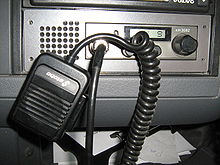Radiotelephony
Under radio or telephony in the radio services is meant the wireless transmission of spoken information by means of handheld radios , mobile radios or base stations. Here, a place radio traffic instead. In most cases, radiotelephony is alternating traffic ( half-duplex operation ): Only one participant can speak while the others listen. A few technologies also allow full duplex operation , comparable to a telephone where you can hear and speak at the same time.
The area of voice radio includes, for example, everyone's radio (e.g. CB radio and PMR446 radio ), taxi radio, sub-areas of train radio , BOS radio , trunked radio , aviation radio , maritime radio , inland waterway radio and sub-areas of amateur radio .
If you want to bridge greater distances on ultra-short waves or send over mountains, an "exchange" is usually interposed, i.e. a relay radio station (also called relay for short ) or a satellite . This switching center picks up the radio waves from the transmitter and transmits them directly on a different frequency, usually with a higher transmission power. This requires that the participating radiotelephones all receive on the transmission frequency of the relay and transmit on the reception frequency of the relay. In Germany, this principle is mainly used in the area of authorities and organizations with security tasks (BOS), i.e. in the police , rescue service , fire brigade and disaster control . A single -frequency radio network is usually operated there within a district , in which several transmitters transmit on the same frequencies and are controlled by the control center as a relay station.
This is unnecessary under special propagation conditions or on the short wave , because there the signals are reflected on partial layers of the atmosphere.
Modes of transport
In voice radio, different types of traffic are known to the devices, which are used depending on the technical equipment.
Exchange traffic (simplex)
The most common type of radio traffic is alternating traffic. With this, all participants send and receive on the same frequency. While one participant is broadcasting, all others can listen. A reply from another participant is only possible afterwards. This can be found, for example, in CB radio , BOS radio, amateur radio, commercial radio or even with simple children's radio devices (walkie-talkies).
Conditional two-way traffic (semi-duplex)
In the semi-duplex method, the radios transmit and receive on two different frequencies, but it is not technically possible to receive while transmitting. The radios have an antenna relay that connects the antenna to either the receiver or the transmitter. Switching is done by pressing the talk button. This type of traffic is used for radio operation via a relay station .
Two-way traffic (duplex)
With two-way traffic, the radio transmits and receives on two different frequencies, which are known as the upper band and the lower band . The radios have a duplex switch , a kind of hybrid circuit that connects the antenna to both the receiving and transmitting parts at the same time, but only lets transmission energy through to the antenna and not to the receiver so that it is not "clogged" or even damaged. While the radio is transmitting on one frequency, it can therefore receive on the other frequency at the same time. Real full duplex operation is only possible with a remote station, which then sends and receives with the tape position reversed . The frequency difference between the upper band frequency and the lower band frequency of the radio channels in a radio network is known as the intercom distance or duplex distance .
By interposing a relay station , larger distances can be bridged and structural or landscape obstacles can be overcome. For this purpose, the relay station receives the voice message from the sender and sends it on at the same time on the second frequency. The relay station is usually installed on a geographic elevation (e.g. mountain top).
Forms of traffic
Based on the form of communication within radio communication circles (i.e. who is allowed to speak to whom), a distinction is made between different forms of traffic.
→ See: Radiotelephony form
Transmission technology
The historically oldest type of modulation for voice radio that can be implemented with the least amount of circuitry is amplitude modulation (AM), as it still prevails in long , medium and shortwave radio and is used in aeronautical and CB radio . Other analog operating modes are frequency modulation (FM), which enables better sound quality with a larger bandwidth and is used in the ultra-short wave range in particular by numerous radio services such as classic VHF radio , as well as the more energy-efficient single sideband modulation (SSB), which is widespread in amateur radio .
With the rise of digital technology , numerous digital voice transmission methods have been added. In addition to the standards available for radio such as DAB, DAB + , DRM and DVB-S, there are, for example, DMR , TETRA and various methods that are also used as amateur radio modes. Some of these are trunked radio systems, which also exist in analog technology (such as MPT 1327 ). In the case of digital radiotelephony methods , it is not only the actual modulation method that matters , but also the codec , i.e. how the voice is translated into digital data on the transmitter side before the modulation part and then back again at the receiver after demodulation.
history
Historical beginnings
The sources are unclear at the beginning of wireless voice transmission. One of the pioneers was Reginald Fessenden , who carried out experiments around 1900.
gallery
See also
Individual evidence
- ↑ Ernst Erb: 1900-09, years of birth of the tubes. In: Radios from yesterday. Radiomuseum Lucerne Foundation, accessed on April 22, 2020 .



